Effects of Ambient Temperature and Relative Humidity on Subsurface Defect Detection in Concrete Structures by Active Thermal Imaging
Abstract
:1. Introduction
2. Related Work
3. Fundamentals of Infrared Thermography
4. Experimental Design and Procedure
4.1. Preparation of Testing Specimen
4.2. Testing Method
5. Analysis of Experimental Results
5.1. Correlation between Ambient Temperature and Relative Humidity
5.2. Effect of Ambient Temperature on the Absolute Contrast
5.3. Effect of Relative Humidity on the Absolute Contrast
5.4. Depth Detection Under Environmental Effect
6. Conclusions
Acknowledgments
Author Contributions
Conflicts of Interest
References
- Portland Cement Association. Types and Causes of Concrete Deterioration; Portland Cement Association: Skokie, IL, USA, 2002. [Google Scholar]
- Bolleni, K.N. Environmental Effects on Subsurface Defect Detection in Concrete Structures Using Infrared Thermography. Master’s Thesis, University of Missouri, Columbia, MO, USA, December 2009. [Google Scholar]
- Maser, K.R. Integration of Ground Penetrating Radar and Infrared Thermography for Bridge Deck Condition Evaluation. In Proceedings of the NDTCE’09, Non-Destructive Testing in Civil Engineering Conference, Nantes, France, 30 June–3 July 2009. [Google Scholar]
- Pollock, D.G.; Dupuis, K.J.; Lacour, B.; Olsen, K.R. Detection of Voids in Prestressed Concrete Bridges Using Thermal Imaging and Ground-Penetrating Radar; WA-RD 717.1; Washington State Transportation Center (TRAC): Pullman, WA, USA, December 2008.
- Vaghefi, K. Infrared Thermography Enhancements for Concrete Bridge Evaluation. Ph.D. Thesis, Michigan Technological Univesity, Houghton, MI, USA, 2013. [Google Scholar]
- Ahlborn, T.M.; Brooks, C.N. Evaluation of Bridge Decks Using Non-Destructive Evaluation at Near Highway Speeds for Effective Asset Management; RC-1617; Michigan Technological University: Houghton, MI, USA, 30 June 2015. [Google Scholar]
- Transportation Research Board. Nondestructive Testing to Identify Concrete Bridge Deck Deterioration; SHRP 2 Report S2-R06A-RR-1; Transportation Research Board: Washington, DC, USA, 2013.
- IAEA. Guidebook on Non-Destructive Testing of Concrete Structures; IAEA: Vienna, Austria, September 2002. [Google Scholar]
- Clemena, G.G.; McKeel, W.T. Detection of delamination in bridge decks with infrared thermography. Transp. Res. Rec. 1978, 664, 180–182. [Google Scholar]
- Cielo, P.; Haldague, X.; Deom, A.A.; Lewak, R. Thermographic Nondestructive Evaluation of Industrial Materials and Structures. Mater. Eval. 1987, 45, 452–460. [Google Scholar]
- Maldague, X.P.V. Nondestructive Evaluation of Materials by Infrared Thermography; Springer: London, UK, 1993. [Google Scholar]
- Washer, G.A.; Fenwick, R.G.; Bolleni, N.K. Development of Hand-Held Thermographic Inspection Technologies; MoDOT Project number RI06-038; University of Missouri: Columbia, MO, USA, 19 August 2009. [Google Scholar]
- Rumbayan, R. Modeling of Environmental Effects on Thermal Detection of Subsurface Damage for Concrete Bridges. Ph.D. Thesis, University of Missouri-Columbia, Columbia, MO, USA, May 2013. [Google Scholar]
- Usamentiaga, R.; Venegas, P.; Guerediaga, J.; Vega, L.; Molleda, J.; Bulnes, F.G. Infrared Thermography for Temperature measurement and non-Destructive Testing. Sensors 2014, 14, 12305–12348. [Google Scholar] [CrossRef] [PubMed]
- Holst, G.C. Common Sense Approach to Thermal Imaging, Bellingham; Spie Optical Engineering Press: Bellingham, WA, USA, 2000. [Google Scholar]
- FLIR System Inc. The Ultimate Infrared Handbook for R&D Professionals; FLIR System Inc.: Hong Kong, China, 2012. [Google Scholar]
- Waldemar, M.; Klecha, D. Modeling of Atmospheric Transmission Coefficient in Infrared for Thermovision Measurements. In Proceedings of the Sensor 2015 and IRS2 2015 AMA Conferences, Nürnberg, Germany, 19 May–21 May 2015. [Google Scholar]
- FLIR. Toolkit IC2 Dig 16: Developers Guide 1.01 for AGEMA 550, 570, ThermaCAM PM 5 cm × 5 and the ThermoVision Family, Version B, FLIR Publication Number: 557 344; FLIR System: Wilsonville, OR, USA, April 2001. [Google Scholar]
- Vollmer, M.; Mollmann, K.P. Infrared Thermal Imaging-Fundamentals, Research and Applications; Wiley: Veinheim, Germany, 2010. [Google Scholar]
- American Concrete Institute. Report on Nondestructive Test Methods for Evaluation of Concrete in Structures; American Concrete Institute: Farmington, MI, USA, 2013. [Google Scholar]
- Dupuis, K.J. Nondestructive Testing of Concrete Box Girder Bridges Using Thermal Imaging. Ph.D. Thesis, Washington State University, Whitman County, WA, USA, May 2008. [Google Scholar]
- Huh, J.; Tran, Q.H.; Lee, J.; Han, D.; Yim, S. Experimental Study on Detection of Deterioration in Concrete Using Infrared Thermography Technique. Adv. Mater. Sci. Eng. 2016, 2016, 12. [Google Scholar] [CrossRef]
- FLIR System Inc. SC660 Catalog, Technical Data of FLIR SC660 Infrared Camera; FLIR System Inc.: Hong Kong, China, 2014. [Google Scholar]
- Allen, R.G.; Pereira, L.S.; Raes, D.; Smith, M. Crop Evapotranspiration: Guidelines for Computing Crop Water Requirements-FAO Irrigation and drainage paper 56. FAO Rome 1998, 300, D05109. [Google Scholar]
- Zhang, J.; Gupta, A.; Baker, J. Effect of Relative Humidity on the Prediction of Natural Convection Heat Transfer Coefficients. Heat Trans. Eng. 2007, 28, 335–342. [Google Scholar] [CrossRef]
- Brown, J.R. Infrared Thermography Inspection of Fiber-Reinforced Polymer Composites Bonded to Concrete. Ph.D. Thesis, University of Florida, Gainesville, FL, USA, 2005. [Google Scholar]
- Brown, J.R.; Hamilton, H.R. Heating Methods and Detection Limits for Infrared Thermography Inspection of Fiber-Reinforced Polymer Composites. ACI Mater. J. 2007, 104, 481–490. [Google Scholar]
- ASTM D4788-07. Standard Test Method for Detecting Delaminations in Bridge Decks Using Infrared Thermography; ASTM International: West Conshohocken, PA, USA, 2007. [Google Scholar]
- FLIR Systems AB. Thermal Imaging Guidebook for Industrial Applications; FLIR Systems AB: Wilsonville, OR, USA, 2011. [Google Scholar]
- Lamond, J.F.; Pielert, J.H. Significance of tests and Properties of Concrete and Concrete-Making Materials; ASTM International: West Conshohocken, PA, USA, 2006. [Google Scholar]
- Cielo, P.; Maldague, X.; Krapez, J.-C.; Lewak, R. Optics-based techniques for the characterization of composites and ceramics. In Nondestructive Characterization of Materials II; Bussiere, J.F., Monchalin, J.P., Ruud, C.O., Green, R.E., Eds.; Springer: Berlin, Germany, 1987; pp. 733–744. [Google Scholar]
- Maldague, X.P. Theory and Practice of Infrared Technology for Nondestructive Testing; John Wiley & Sons: New York, NY, USA, 2001. [Google Scholar]

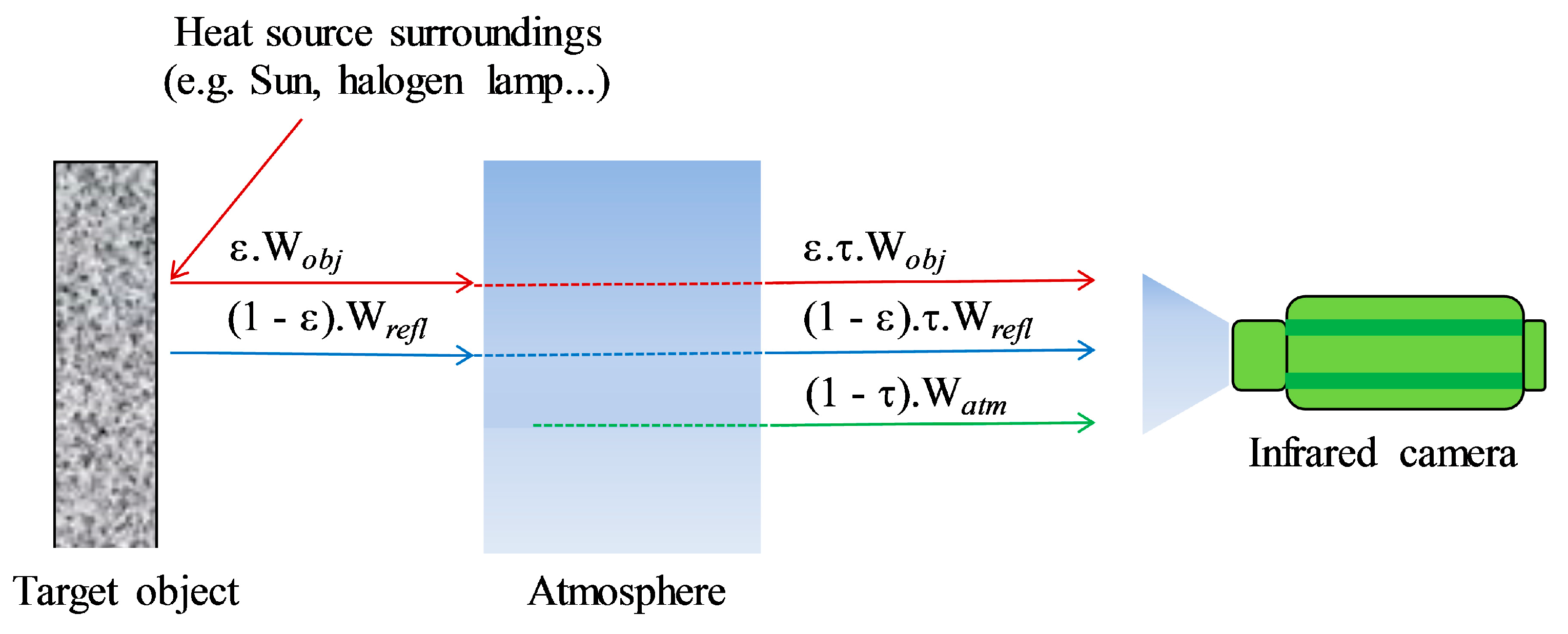

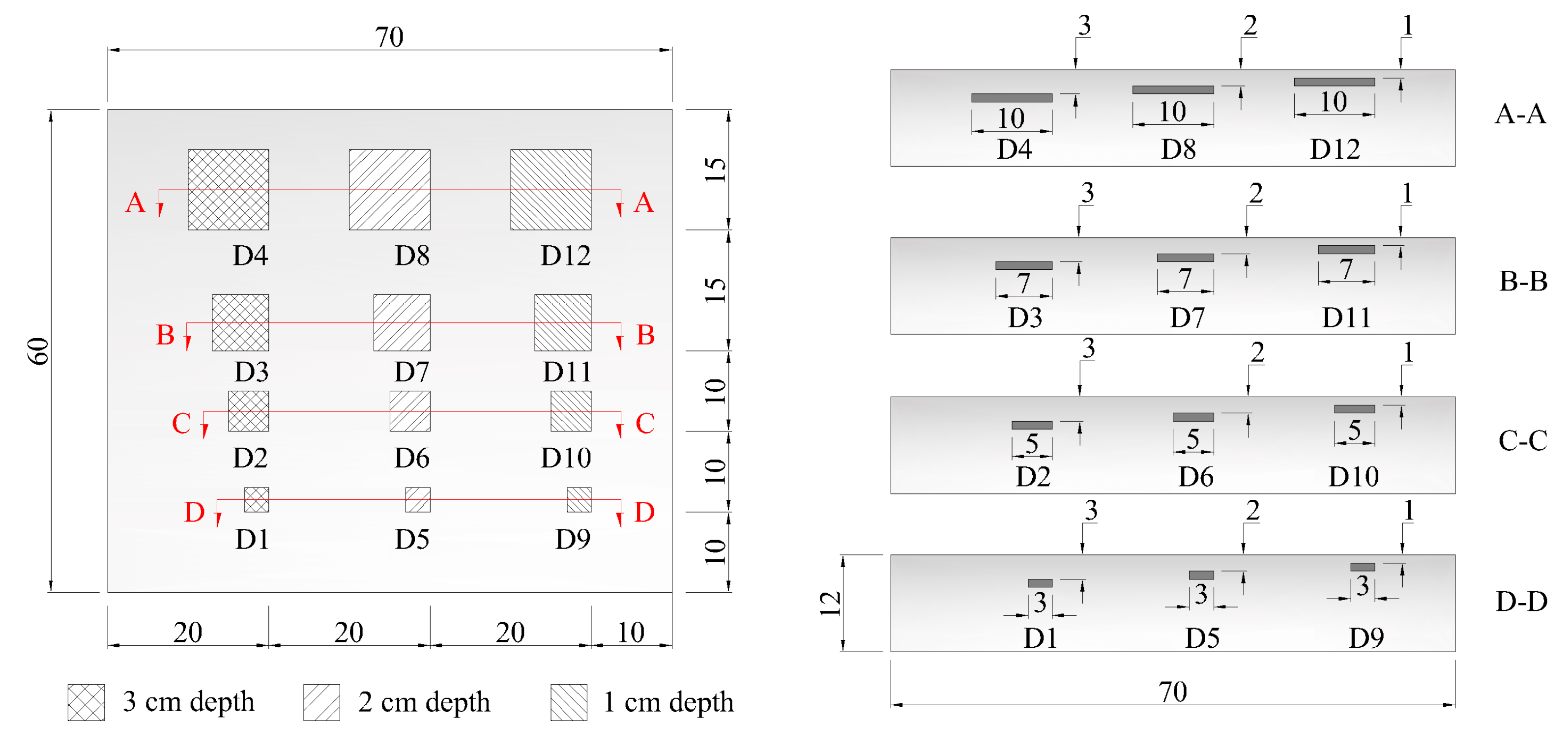

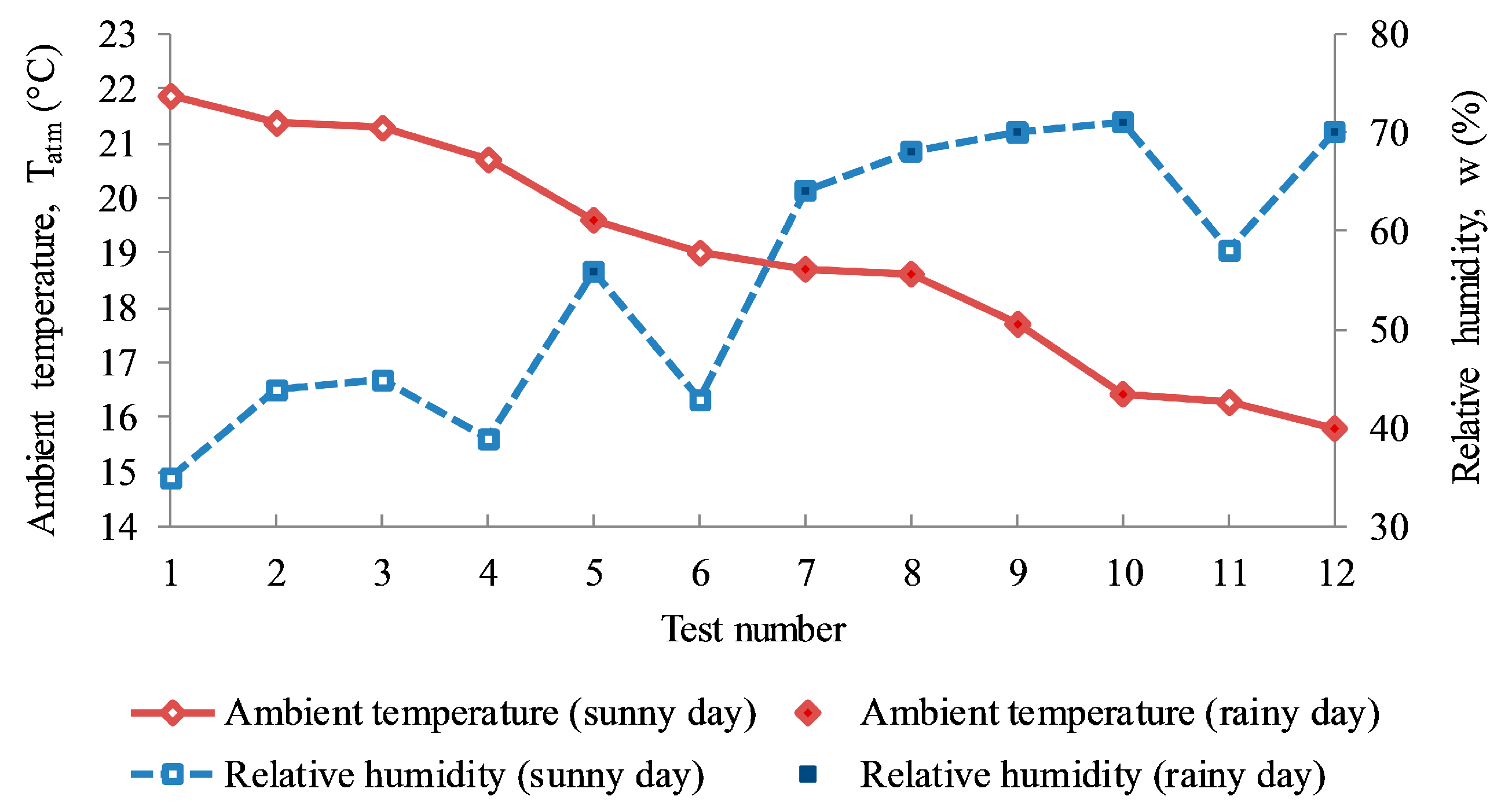
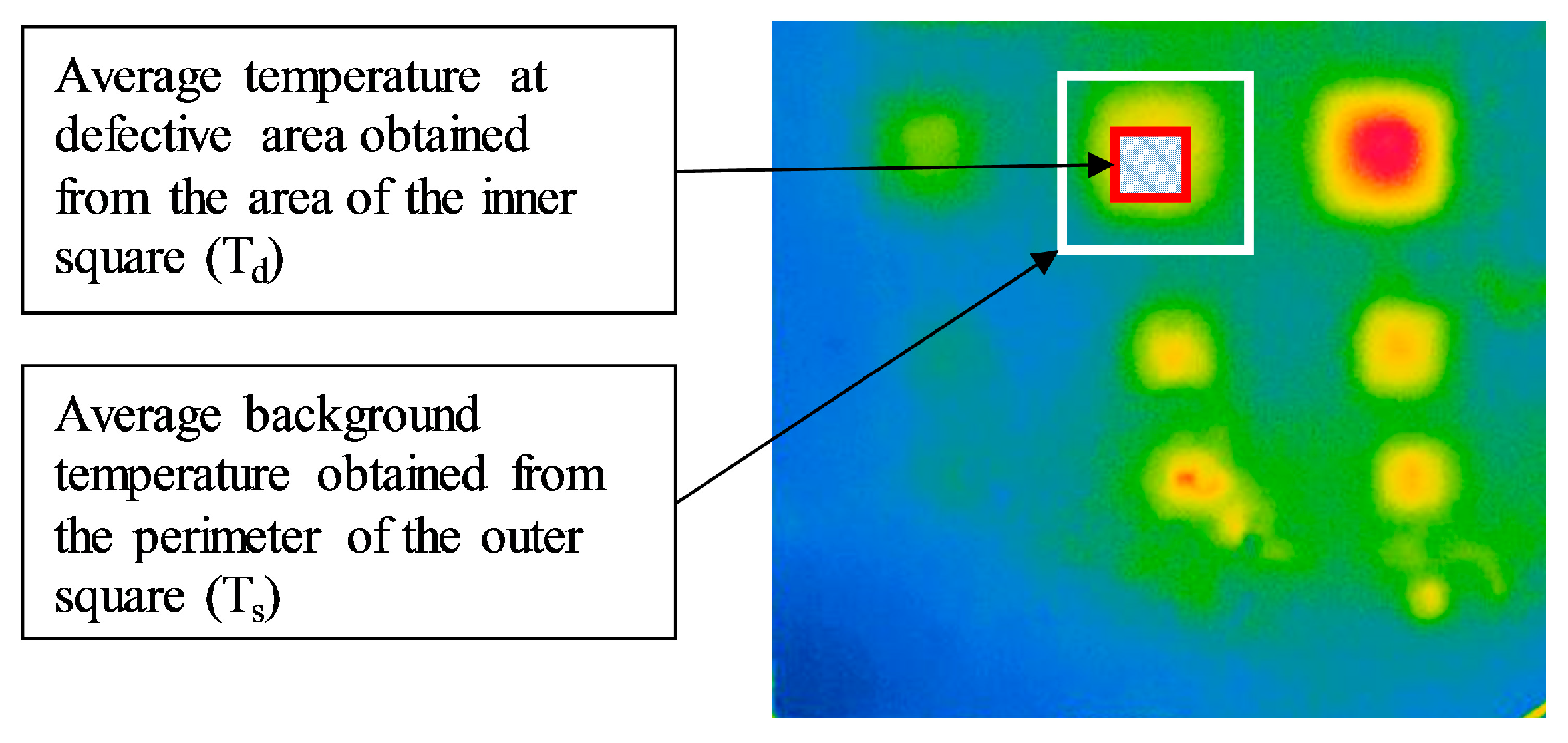
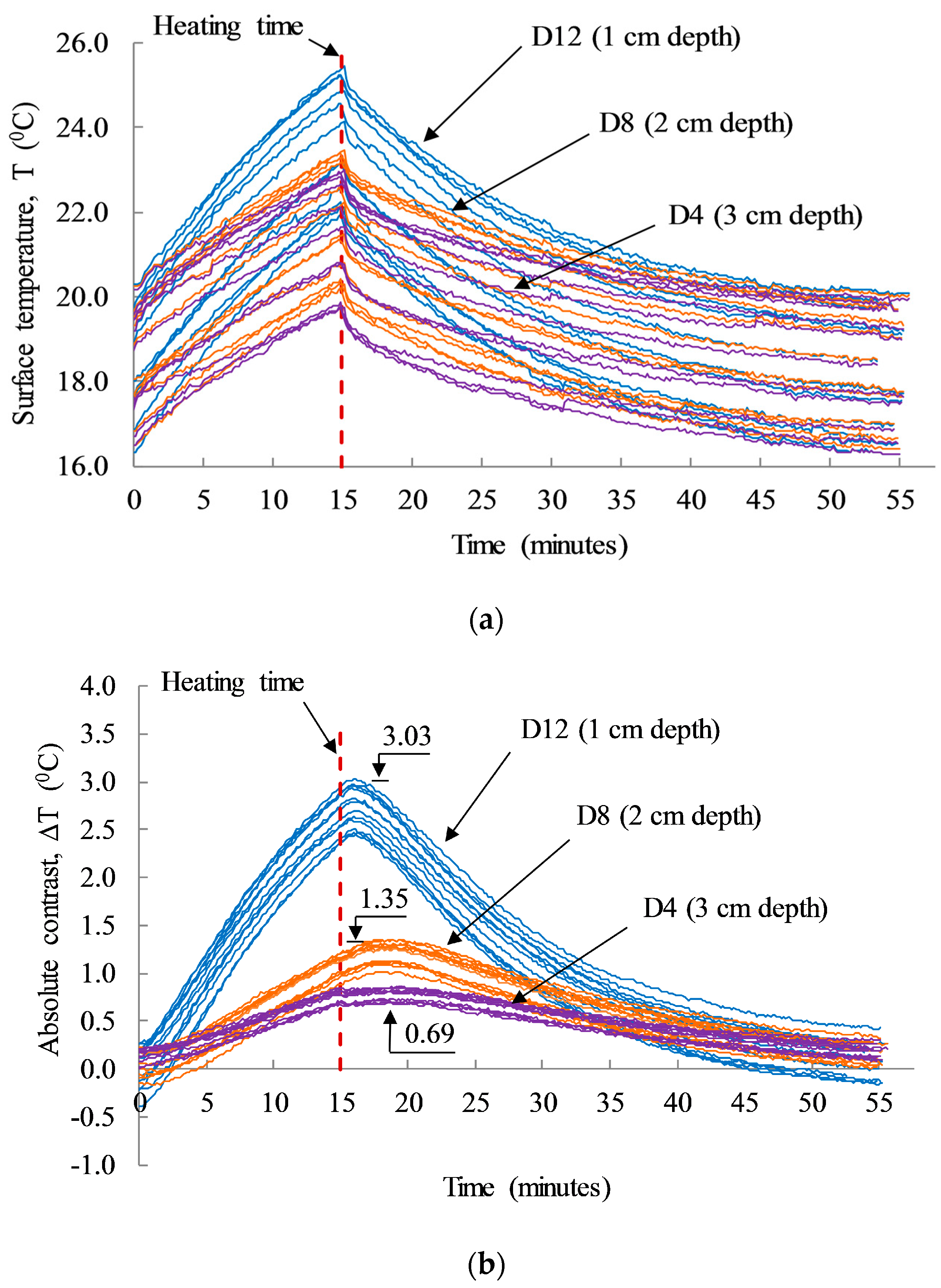

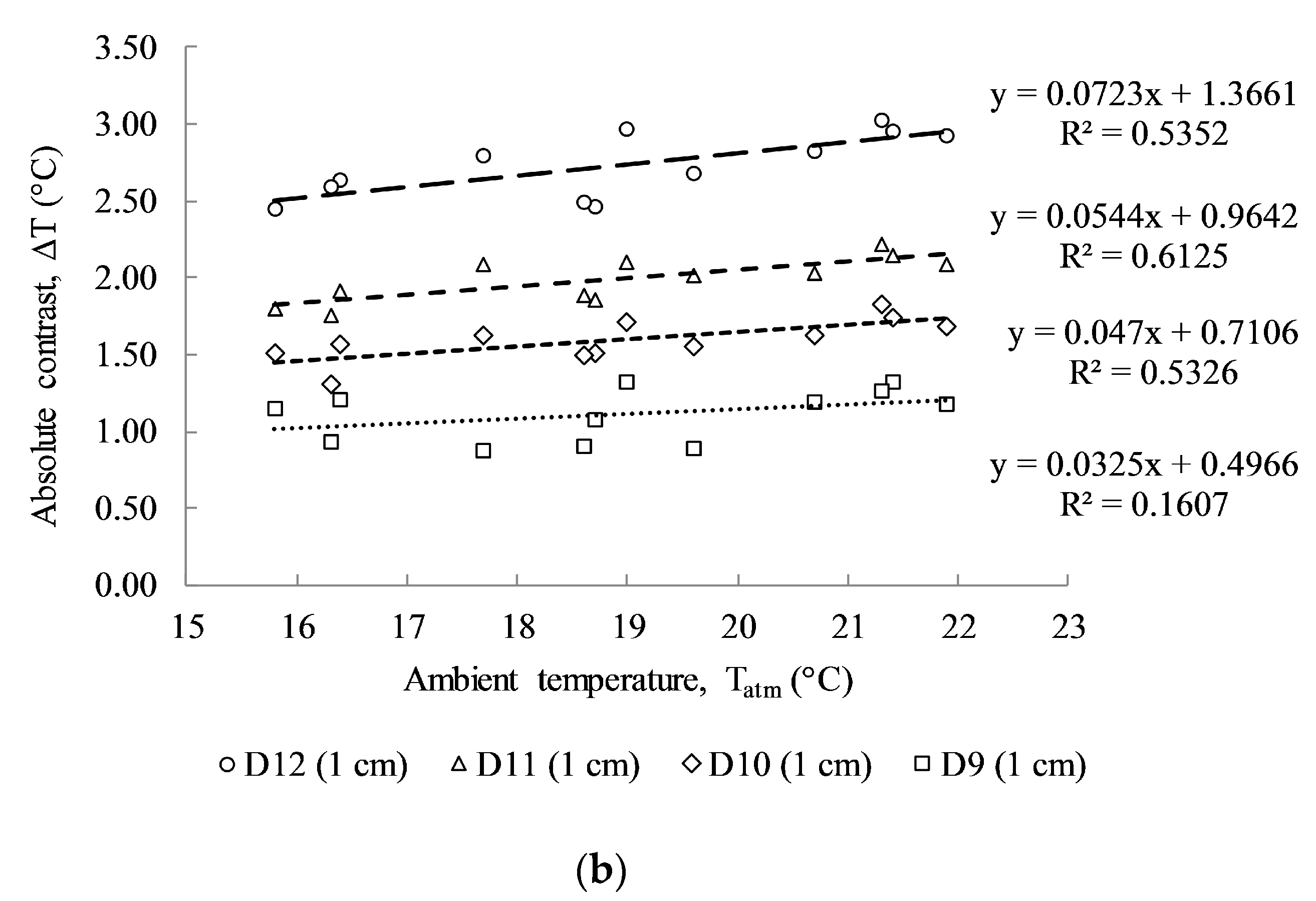
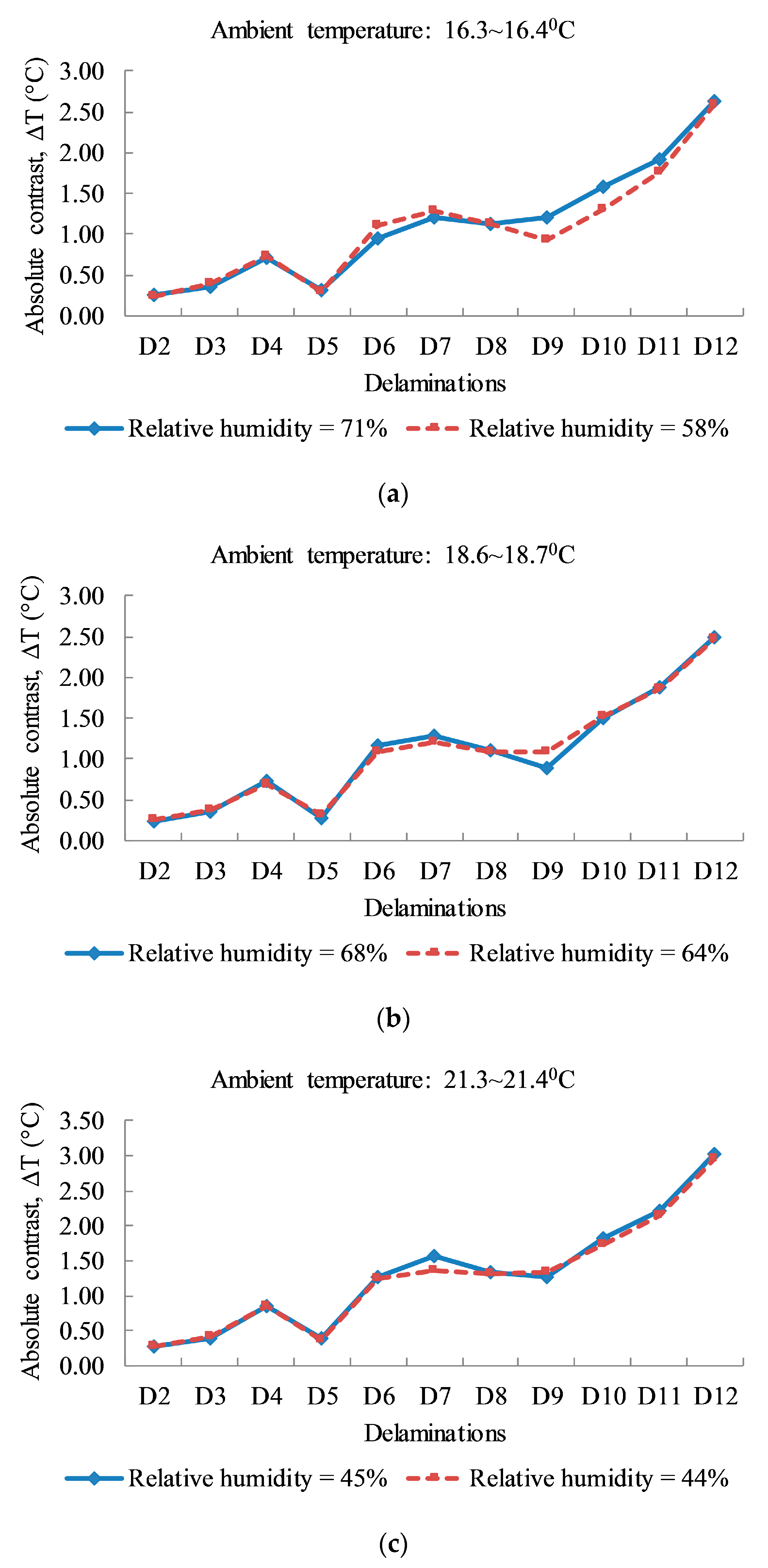
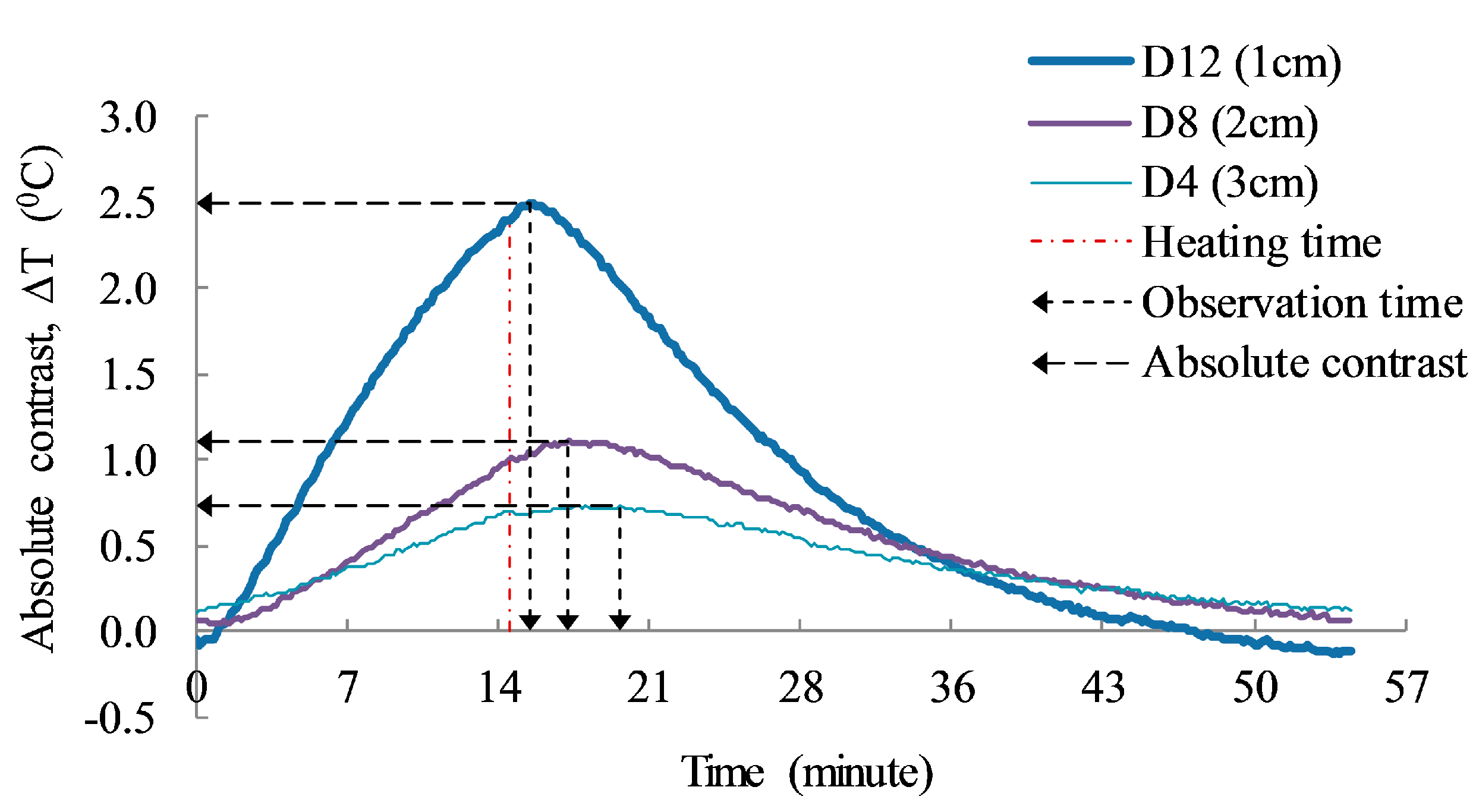
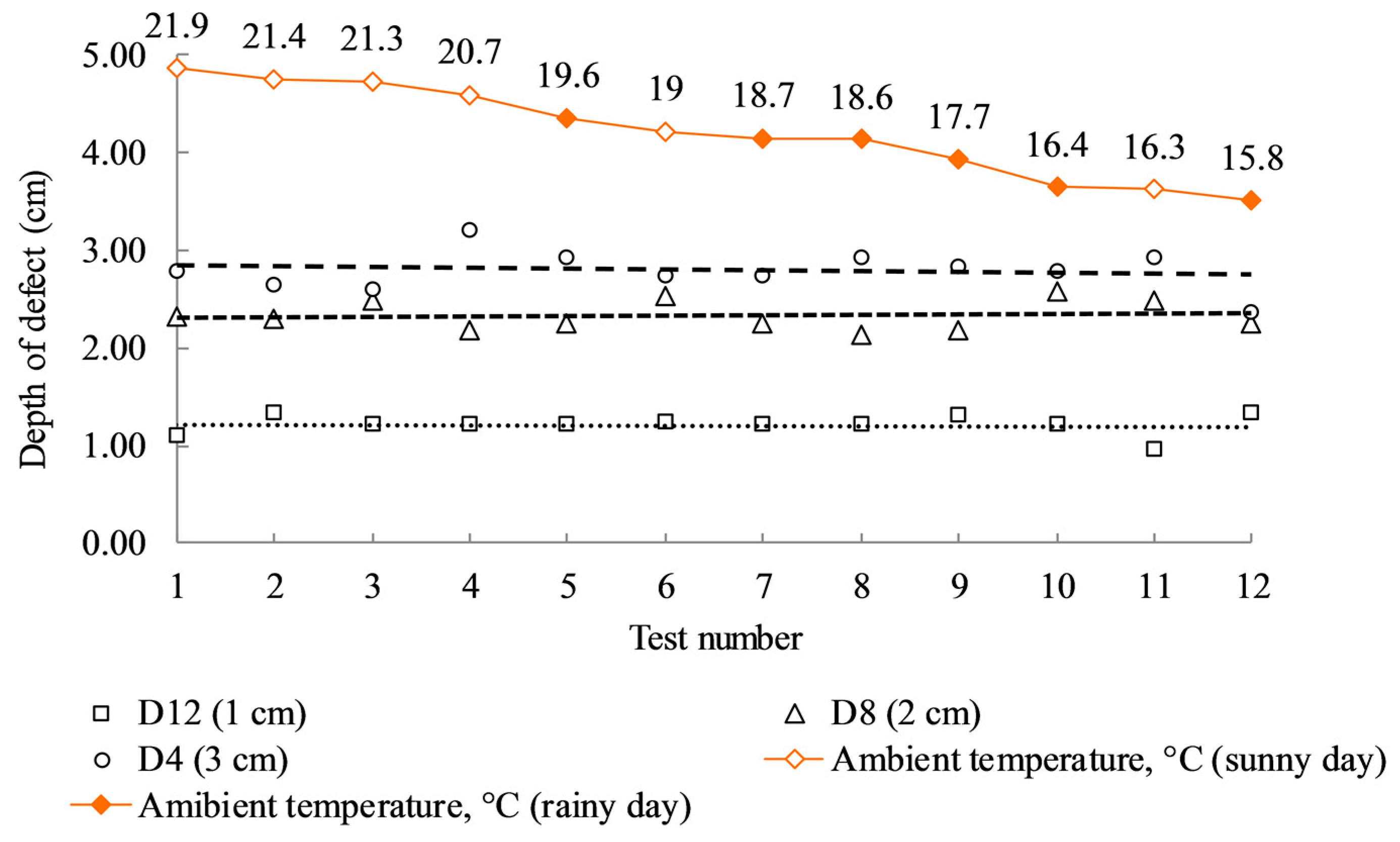
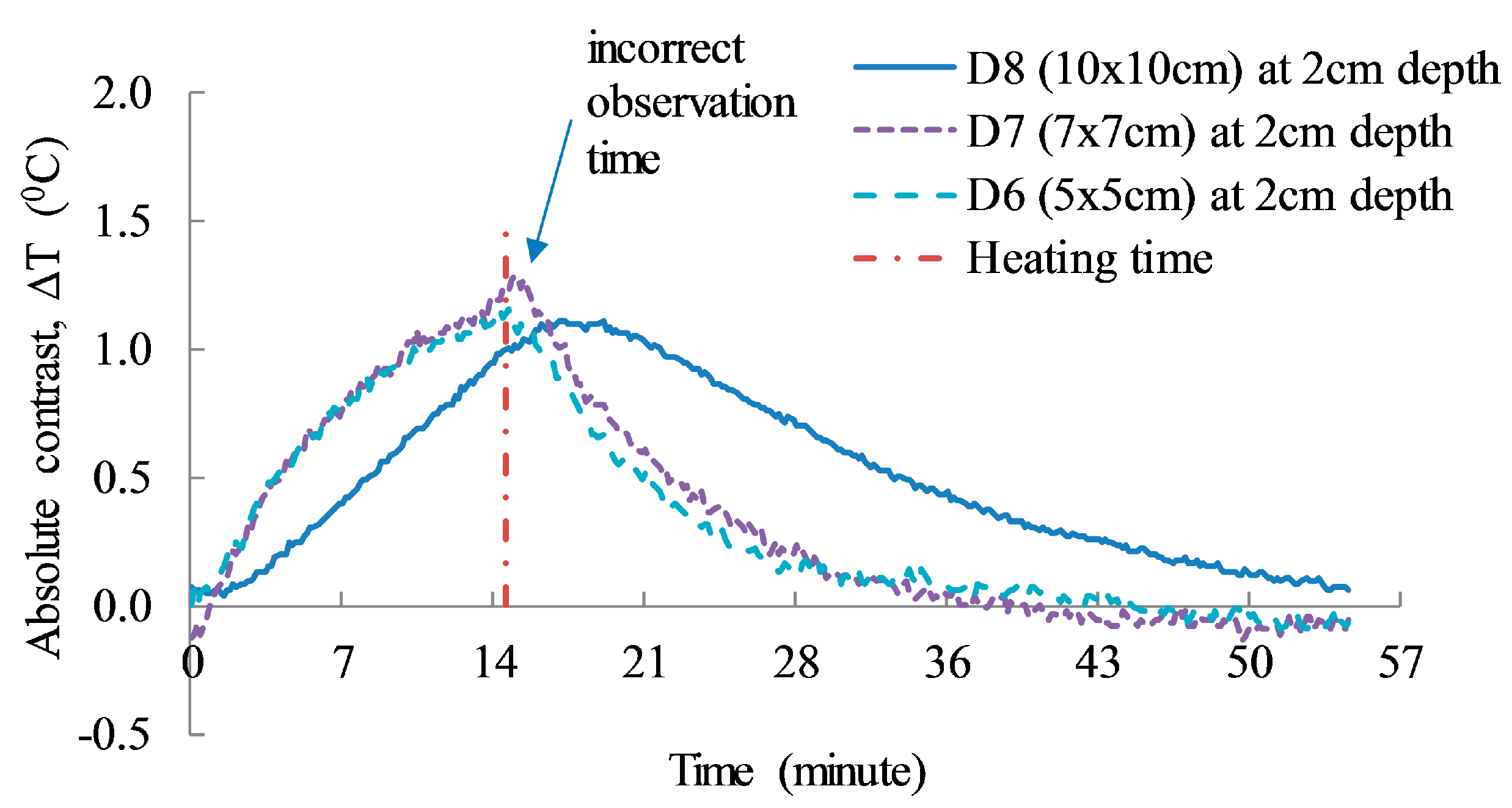
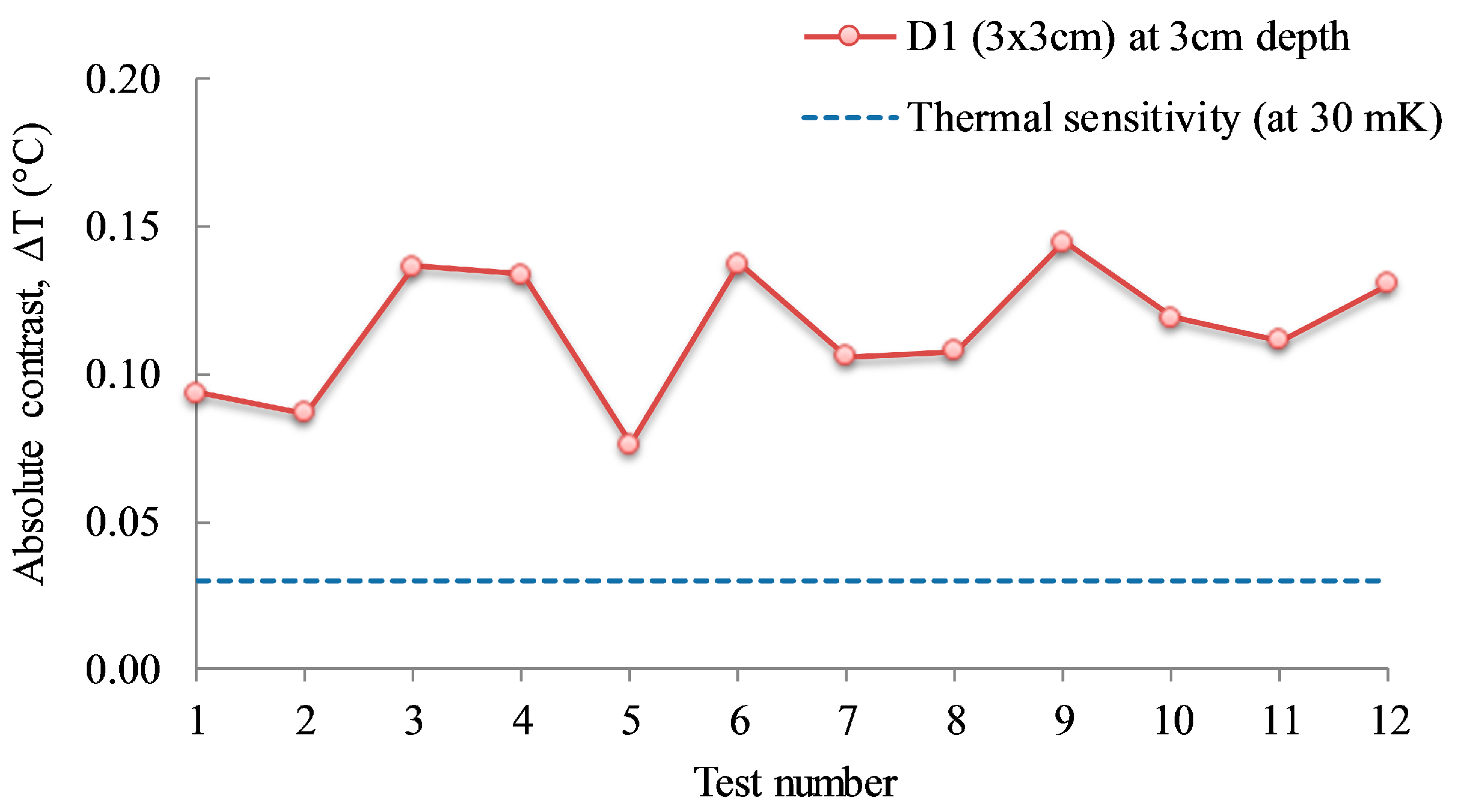
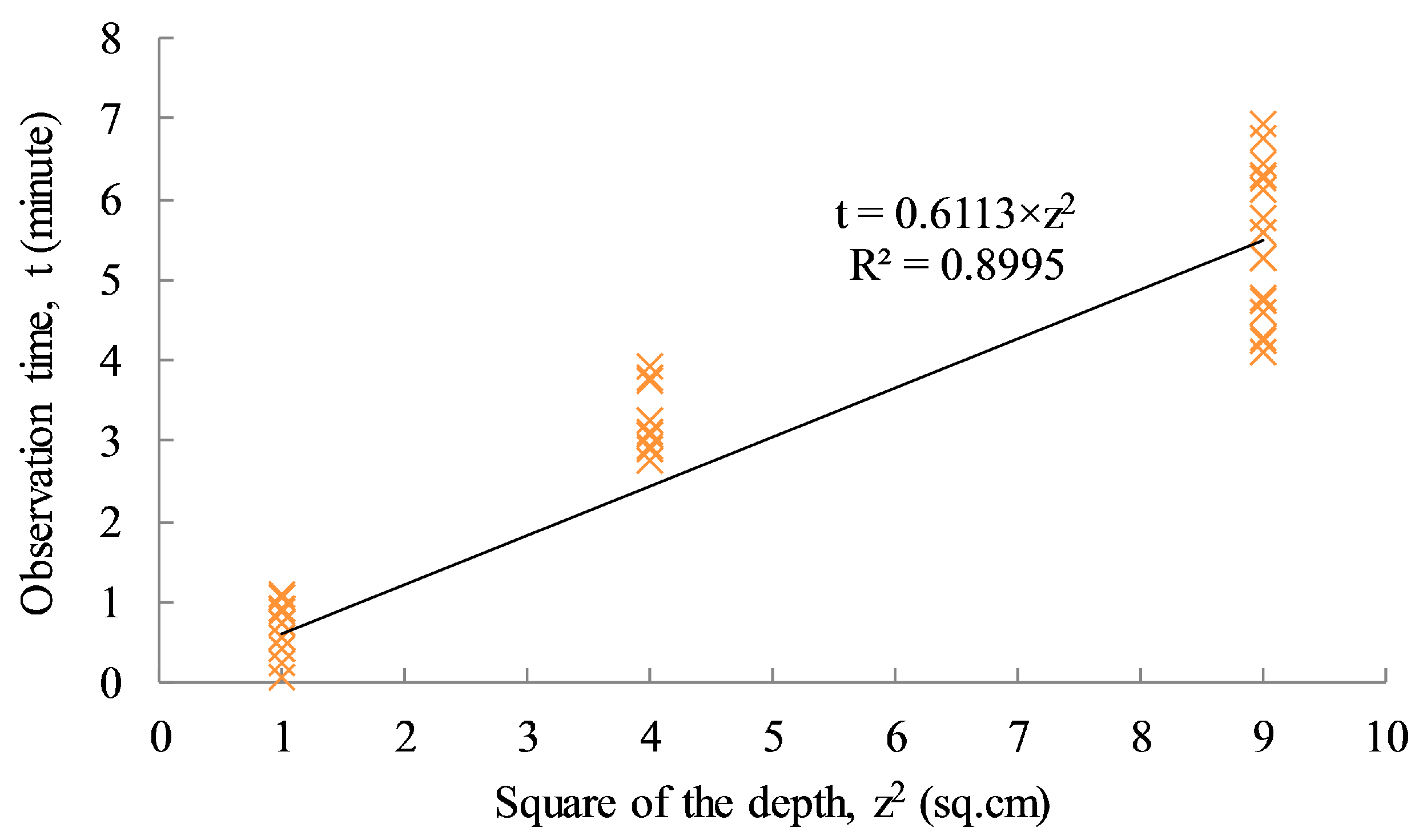
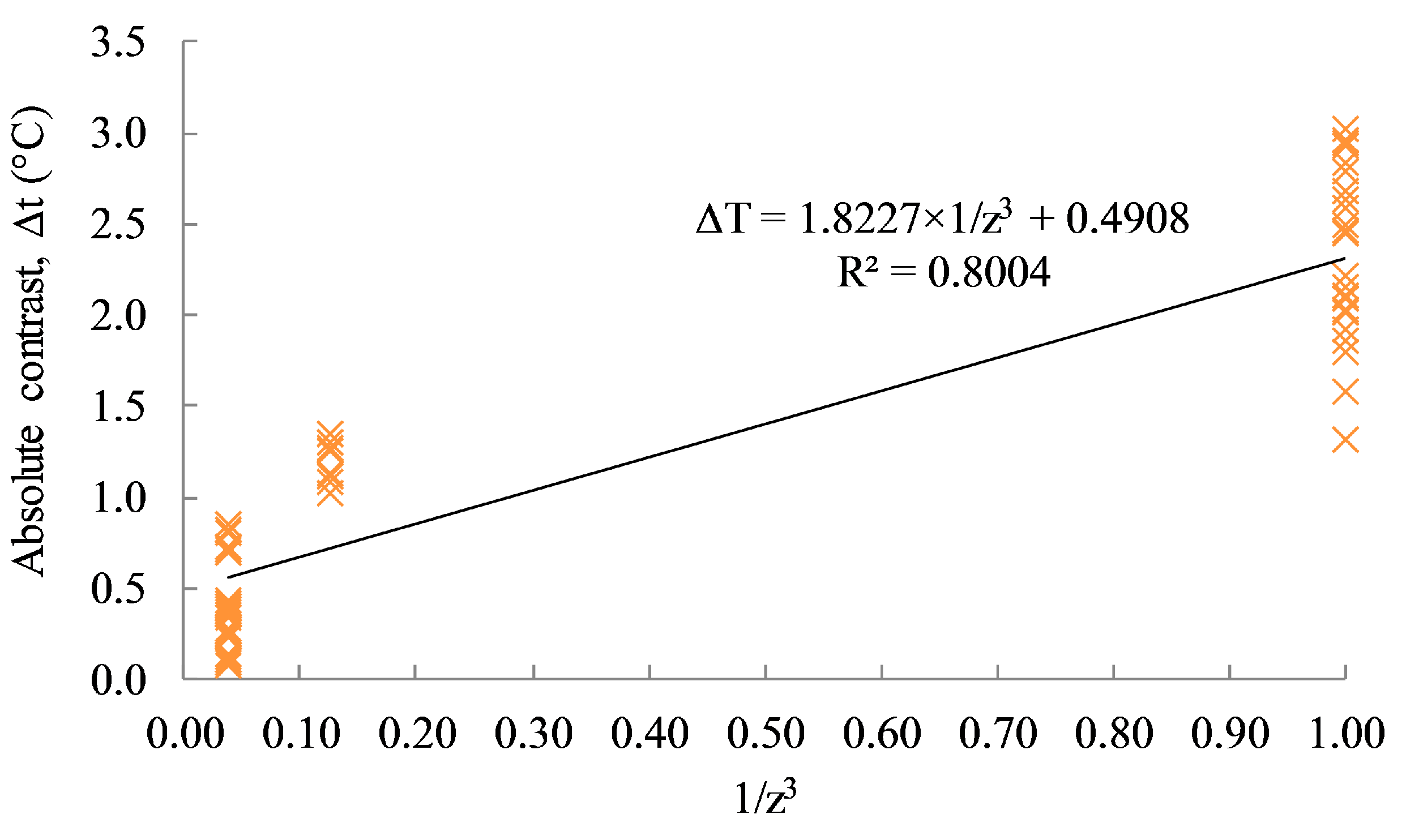
| Items | Parameters |
|---|---|
| IR resolution | 640 × 480 pixels |
| Thermal sensitivity/NETD | <30 mK @ + 30 °C |
| Field of view (FOV) | 24° × 18°/0.3 m |
| Spatial resolution (IFOV) | 0.65 mrad |
| Focal Plane Array (FPA) | Uncooled microbolometer |
| Wavelength | 7.5~13 μm |
| Temperature range | −40 °C~+120 °C |
| Accuracy | ±1 °C or ±1% of reading |
| Measurement No. | Meteorological Conditions | Ambient Temperature (°C) | Relative Humidity (%) |
|---|---|---|---|
| 1 | sunny day | 21.9 | 35 |
| 2 | sunny day | 21.4 | 44 |
| 3 | sunny day | 21.3 | 45 |
| 4 | sunny day | 20.7 | 36 |
| 5 | cloudy after the rain | 19.6 | 66 |
| 6 | sunny day | 19.0 | 37 |
| 7 | light rain | 18.7 | 64 |
| 8 | cloudy after the rain | 18.6 | 68 |
| 9 | showers | 17.7 | 70 |
| 10 | moderate rain | 16.4 | 71 |
| 11 | sunny day | 16.3 | 58 |
| 12 | light rain | 15.8 | 70 |
| Researcher | Density, ρ | Type of Aggregate | Thermal Diffusivity α = K/ρ C | Method |
|---|---|---|---|---|
| (kg/m3) | (cm2/min) | |||
| Maldague, 1993 [11] | 2400 | - | 0.318 | - |
| Maldague, 2001 [32] | 2400 (dry) | - | 0.318 | - |
| 2500 (moist) | - | 0.336 | - | |
| Lamond, 2006 [30] | - | Quartz | 1.317 | CRD-C 36, 37 |
| Quartzite | 1.017 | CRD-C 36, 37 | ||
| Limestone | 0.917 | CRD-C 36, 37 | ||
| Basalt | 0.417 | CRD-C 36, 37 | ||
| Expanded shale | 0.250 | CRD-C 36, 37 | ||
| Vollmer, 2010 [19] | - | - | 0.396 (at 20 °C) | - |
| Ahlborn, 2015 [6] | - | Quartz | 1.425 | IRT 1 |
© 2017 by the authors. Licensee MDPI, Basel, Switzerland. This article is an open access article distributed under the terms and conditions of the Creative Commons Attribution (CC BY) license (http://creativecommons.org/licenses/by/4.0/).
Share and Cite
Tran, Q.H.; Han, D.; Kang, C.; Haldar, A.; Huh, J. Effects of Ambient Temperature and Relative Humidity on Subsurface Defect Detection in Concrete Structures by Active Thermal Imaging. Sensors 2017, 17, 1718. https://doi.org/10.3390/s17081718
Tran QH, Han D, Kang C, Haldar A, Huh J. Effects of Ambient Temperature and Relative Humidity on Subsurface Defect Detection in Concrete Structures by Active Thermal Imaging. Sensors. 2017; 17(8):1718. https://doi.org/10.3390/s17081718
Chicago/Turabian StyleTran, Quang Huy, Dongyeob Han, Choonghyun Kang, Achintya Haldar, and Jungwon Huh. 2017. "Effects of Ambient Temperature and Relative Humidity on Subsurface Defect Detection in Concrete Structures by Active Thermal Imaging" Sensors 17, no. 8: 1718. https://doi.org/10.3390/s17081718






